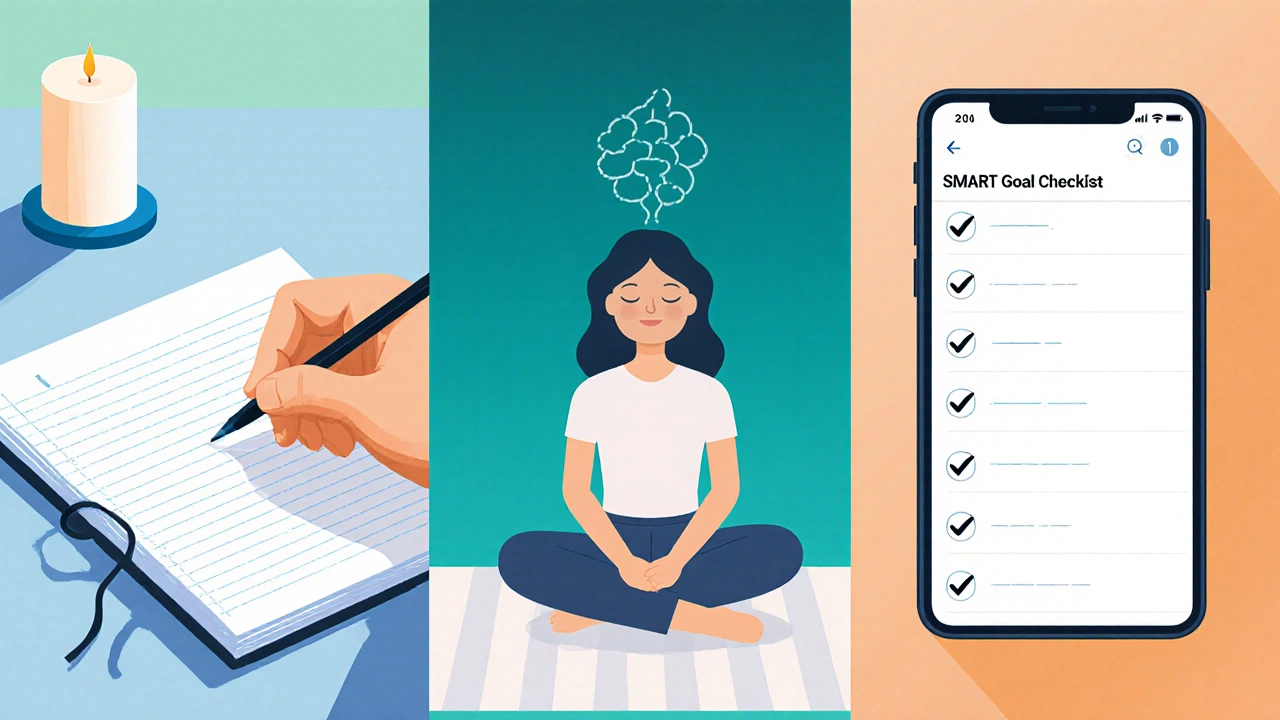SMART Goals Calculator
Create Your SMART Goal
Turn your vague intentions into actionable goals. Enter your goal below and let this tool help you make it specific, measurable, and achievable.
When you ask, “How can I help myself get better?” you’re looking for practical steps you can start today, not vague advice. Below is a down‑to‑earth guide that mixes science, everyday tools, and a pinch of mindset work so you can see real change.
Key Takeaways
- Start with one tiny habit and use the habit‑stacking trick to make it stick.
- Set SMART goals that are specific, measurable, achievable, relevant, and time‑bound.
- Practice mindfulness - a simple 5‑minute daily check‑in that boosts focus and reduces stress.
- Use a journal to track wins, setbacks, and lessons.
- Find an accountability partner who keeps you honest.
What Self‑Improvement Actually Means
Self‑improvement is a lifelong process of expanding your skills, mindset, and habits to become a better version of yourself. It isn’t a badge you earn; it’s a series of small, repeatable actions that add up over weeks and months. Think of it like building a house brick by brick rather than trying to lift the whole building at once.
1. Choose One Tiny Habit and Stack It
The brain resists change, but it loves tiny, predictable actions. Pick a habit that takes under two minutes - for example, drinking a glass of water as soon as you wake up.
Then habit‑stacking (a term coined by James Clear) lets you attach the new habit to an existing routine. If you already brush your teeth, set a glass of water next to the sink and say, “After I finish brushing, I’ll drink the water.” The cue is already there, so you’re more likely to follow through.
2. Set SMART Goals That Actually Move You
Goals that are vague (“I want to read more”) rarely get done. A SMART goal breaks the ambition into concrete steps. Here’s a quick template you can copy:
- Specific: I will read 20 pages of a non‑fiction book.
- Measurable: I’ll log the pages in a habit app.
- Achievable: 20 pages take about 15 minutes.
- Relevant: The book aligns with my career growth.
- Time‑bound: I’ll do this every weekday at 7 p.m. for the next four weeks.
When you can tick each box, the goal feels doable, and progress becomes visible.
3. Bring Mindfulness Into Your Day
Mindfulness isn’t just meditation; it’s a mental habit of paying attention to the present moment without judgment. A five‑minute breath‑focus session each morning can sharpen concentration and lower anxiety.
Try this simple routine:
- Sit upright, feet flat on the floor.
- Set a timer for 5 minutes.
- Inhale for a count of 4, hold for 2, exhale for 6.
- If thoughts drift, gently label them (“thinking”) and return to the breath.
Within a week you’ll notice you’re less likely to react impulsively in stressful situations.

4. Journal Your Progress - The Power of the Written Word
Writing forces the brain to organize thoughts. A journal can be as simple as a bullet‑point list. Track three items each night:
- What I did well today.
- One thing I could improve.
- One action I’ll take tomorrow.
Over time you’ll spot patterns - maybe you’re most productive after a short walk, or you struggle when you skip lunch. Those insights guide future habit tweaks.
5. Find an Accountability Partner
Social pressure works better than willpower alone. Choose someone who shares a similar goal - a friend who wants to run, a colleague learning a new language, or even a supportive online community.
Set a weekly check‑in (quick call or message) where each person shares their wins and challenges. If you miss a deadline, the partner’s gentle nudge can pull you back on track.
6. Use Time‑Blocking and the Pomodoro Technique
Time‑blocking reserves chunks of your calendar for specific activities. Pair it with the Pomodoro Technique, which breaks work into 25‑minute focus periods followed by a 5‑minute break. This combo prevents the “I’ll just check email later” trap.
Example schedule for a Tuesday:
- 08:00‑08:30 - Morning routine (mindfulness + water habit)
- 09:00‑09:25 - Pomodoro 1: Write project outline
- 09:25‑09:30 - Break (stretch)
- 09:30‑09:55 - Pomodoro 2: Research sources
- …
When you see the day divided into clear blocks, procrastination loses its foothold.
7. Pick the Right Habit‑Tracking Tool
Many apps promise to keep you on track, but not all suit every personality. Below is a quick side‑by‑side look at three popular options.
| App | Best For | Key Feature | Cost |
|---|---|---|---|
| Habitica | Gamers who love RPG elements | Turn habits into quests & earn rewards | Free, optional $4.99/mo premium |
| Streaks | iOS users who want a simple UI | Visual streak counter with 12‑habit limit | $4.99 one‑time |
| Loop Habit Tracker | Android users seeking open‑source | Flexible frequency settings, detailed graphs | Free (open source) |
Pick the one that matches your style - the best app is the one you’ll actually open every day.
8. Adopt a Growth Mindset
Carol Dweck’s research shows that believing abilities can be developed (a growth mindset) leads to higher achievement than a fixed mindset.
When you stumble, replace “I’m terrible at this” with “I’m learning how to do this better.” Over time this mental shift fuels perseverance across all habits.
Putting It All Together - A 30‑Day Blueprint
Here’s a ready‑made plan that weaves every piece above into a single month:
- Day 1‑3: Choose your tiny habit (water glass) and set up habit‑stacking.
- Day 4‑7: Write your first SMART goal and add it to a habit app.
- Day 8‑10: Start daily 5‑minute mindfulness sessions.
- Day 11‑13: Begin journaling each night.
- Day 14: Pair up with an accountability partner; schedule weekly check‑ins.
- Day 15‑20: Implement time‑blocking + Pomodoro for work tasks.
- Day 21‑23: Test the three habit‑tracking apps; settle on one.
- Day 24‑27: Read a short article on growth mindset; reframe any setbacks.
- Day 28‑30: Review journal entries, adjust goals, celebrate wins.
At the end of the month you’ll have a habit stack, a SMART goal pipeline, a mindfulness practice, a journal habit, an accountability buddy, a time‑management system, a chosen tracking app, and a growth‑mindset habit. That’s a solid foundation for any future self‑improvement project.
Common Pitfalls and How to Dodge Them
- Trying to change everything at once: Stick to one habit for at least 21 days before adding another.
- Setting vague goals: Use the SMART framework every time.
- Skipping reflection: Your journal is the only place to see real data; ignore it and you’ll repeat mistakes.
- Choosing the wrong tool: Test free versions first; don’t pay for features you won’t use.
- Lacking social support: Even a brief text from an accountability partner can boost adherence.
Frequently Asked Questions
How long does it really take to form a new habit?
Research from the University College London suggests the average is 66 days, but the range is wide - 18 to 254 days. The key is consistency, not the exact number.
Can I use more than one habit‑tracking app?
Yes, some people keep a simple visual streak board (like a whiteboard) for high‑impact habits and use an app for detailed metrics on others. Just keep the system simple enough to stay engaged.
What if I miss a day?
Don’t treat it as a failure. Note the skip in your journal, identify the trigger, and get back on track the next day. A single miss doesn’t erase weeks of progress.
Is mindfulness the same as meditation?
Meditation is a formal practice; mindfulness is the broader skill of staying present, which you can apply while washing dishes, walking, or working.
Do I need an expensive planner to time‑block?
No. A simple Google Calendar or a free printable grid works fine. The habit, not the tool, drives results.
Start with the tiny habit today. The rest of the system will fall into place as you build momentum.






